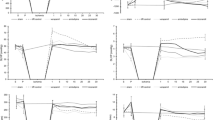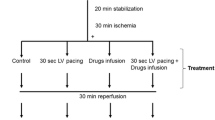Abstract
Noradrenaline in a micromolar concentration has recently been shown to contribute to ischemic tissue injury by direct cardiotoxic effects independent of functional alterations. Oxygen free radicals, generated during the auto-oxidation of catecholamines, are important mediators of catecholamine cardiotoxicity. However, the role of the oxidative products (aminochromes) is still unclear. We examined the effects of adrenochrome on functional parameters and on regional myocardial ischemia (MI) in isolated electrically-driven rabbit hearts with depleted catecholamine stores (reserpine 7.0 mg/kg i.p. 16–24 h before preparation, Langendorff, constant pressure: 70 cm H2O, Tyrode solution, Ca++ 1.8 mmol/l, 37°C). Repetitive MI, separated by a reperfusion period of 50 min, was induced by coronary artery branch ligature, and MI was quantitated from epicardial NADH fluorescence photography. Adrenochrome-treatment (10−6 M or 10−4 M) was started after a reperfusion period of 20 min. The left ventricular pressure (LVP) was significantly enhanced by adrenochrome (p<0.05), but it fell thereafter to below its initial value in hearts treated with adrenochrome 10−4 M. The global coronary flow (CF) was not affected by adrenochrome 10−6 M (P>0.05), but it was significantly decreased by adrenochrome 10−4 M (P<0.05). The relative CF (=CF/LVP×heart-rate) was numerically decreased by adrenochrome 10−6 M (p>0.05) and more markedly by adrenochrome 10−4 M (p<0.05). Whereas epicardial NADH fluorescence was similar after repetitive coronary artery occlusions in controls and in hearts treated with adrenochrome 10−6 M (p>0.05), it was significantly enhanced by adrenochrome 10−4 M (p<0.05). In isolated rabbit hearts, adrenochrome possesses deleterious effects on MI only at a very high concentration but not in a micromolar concentration. Therefore, it seems that aminochromes may be less cardiotoxic than catecholamines.
Similar content being viewed by others
References
Baller D, Bretschneider HJ, Hellige G (1979) Validity of myocardial oxygen consumption parameters. Clin Cardiol 2: 317–327
Barlow CH, Harken AD, Chance B (1977) Evaluation of cardiac ischemia by NADH fluorescence photography. Ann Surg 186: 737–740.
Bindoli A, Rigobello MP, Galzigna L (1989) Toxicity of aminochromes. Toxicol Lett 48: 3–20
Dhalla KS, Ganguly PK, Rupp H, Beamish RE, Dhalla NS (1989) Measurement of adrenolutin as an oxidation product of catecholamines in plasma. Mol Cell Biochem 87: 85–92
Dhalla NS, Yates JC, Naimark B, Dhalla KS, Beamish RE, Ostadal B (1992) Cardiotoxicity of catecholamines and related agents. In: Acosta Jr D (ed) Cardiovascular toxicology. Raven Press, New York, pp 239–282
Feild BJ, Russel RO Jr, Dowling JT, Rackley CE (1972) Regional left ventricular performance in the year following myocardial infarction. Circulation 46: 679–689
Fornstedt B, Rosengren E, Carlsson A (1986) Occurence and distribution of 5-S-cysteinyl derivatives of dopamine, dopa and dopac in the brains of eight mammalian species. Neuropharmacology 25: 451–454
Krall AR, Siegel GJ, Goznaski DM, Wagner FL (1964) Adrenochrome inhibition of oxidative phosphorylation by rat brain mitochondria. Biochem Pharmacol 12: 1519–1525
Langendorff O (1895) Untersuchungen am überlebenden Säugetierherzen. Arch Gen Physiol 61: 291–332
Matthews SB, Henderson AH, Campbell AK (1985) The adrenochrome pathway: the major route for adrenaline catabolism by polymorphonuclear leucocytes. J Mol Cell Cardiol 17: 339–348
Ostadal B, Rychterova V, Poupa O (1968) Isoproterenol-induced acute experimental cardiac necrosis in the turtle. Am Heart J 76: 645–649
Richardt G, Lumpp U, Haass M, Schömig A (1990) Propranolol inhibits nonexocytotic noradrenaline release in myocardial ischemia. Naunyn-Schmiedeberg’s Arch Pharmacol 341: 50–55
Rosengren E, Linder-Eliasson E, Carlsson A (1985) Detection of 5-S-cysteinyl-dopamine in human brain. J. Neurol Transm 63: 247–253
Rump AFE, Rösen R, Sigmund B, Fuchs J, Klaus W (1992) Studies on the influence of Bay K 8644 on hemodynamics and the size of a regional ischemia in isolated rabbit hearts. J Mol Cell Cardiol 24 [Suppl I]: 85
Rump AFE, Klaus W (1994) Evidence for norepinephrine cardiotoxicity mediated by superoxide anion radicals in isolated rabbit hearts. Naunyn-Schmiedeberg’s Arch Pharmacol 349: 295–300
Rump AFE, Rösen R, Klaus W (1993a) Cardioprotection by super-oxide dismutase: a catecholamine-dependent process? Anesth Analg 76: 239–246
Rump AFE, Rösen R, Korth A, Klaus W (1993b) Deleterious effect of exogenous angiotensin-I on the extent of regional ischaemia and its inhibition by captopril. Eur Heart J 14: 106–112
Rump AFE, Blazincic B, Klaus W (1993c) Effect of amrinone and milrinone on myocardial ischemia extent and infarct size in isolated rabbit hearts. Arzneimittelforschung 43 [II]: 1262–1266
Rump AFE, Rösen R, Sigmund B, Fuchs J, Ratke R, Klaus W (1993d) Influence of dihydropyridine-type calcium agonists on hemodynamics and myocardial ischemia in isolated rabbit hearts. Arzneimittelforschung 43: 1056–1059
Rump AFE, Acar D, Rösen R, Klaus W (1994) Functional and anti-ischaemic effects of the phosphodiesterase inhibitor levosimendan in isolated rabbit hearts. Pharmacol Toxicol 74: 244–248
Schömig A, Kurz T, Richardt G, Schömig E (1988) Neuronal sodium homeostasis and axoplasmic amine concentrations determine calcium-independent noradrenaline release in normoxic and ischemic rat heart. Circ Res 63: 214–226
Sole MJ (1988) Sympathetic innervation of the failing heart: pathophysiological implications. In: Kulbertus HE, Franck G (eds) Neurocardiology. Futura, New York, pp 201–209
Taam GML, Takeo S, Ziegelhoffer A, Singal PK, Beamish RE, Dhalla NS (1986) Effect of adrenochrome of adenine nucleotides and mitochondrial phosphorylation in rat heart. Can J Cardiol 2: 88–93
Author information
Authors and Affiliations
Rights and permissions
About this article
Cite this article
Rump, A.F.E., Klaus, W. Cardiotoxicity of adrenochrome in isolated rabbit hearts assessed by epicardial NADH fluorescence. Arch Toxicol 68, 571–575 (1994). https://doi.org/10.1007/s002040050116
Received:
Accepted:
Issue Date:
DOI: https://doi.org/10.1007/s002040050116




